Neon tetras are small, brightly colored freshwater fish that are popular among aquarium hobbyists. These fish are relatively easy to care for, but there are some important things to keep in mind if you want to keep them healthy and happy.
Neon tetras require a well-maintained aquarium with suitable water conditions, a varied diet, and a peaceful environment. They need a pH range of 6.0-7.5 and a temperature range between 72-78°F. The aquarium should be planted, and regular water changes should be performed to ensure their health.
In this article, I’ll share some tips and tricks for caring for neon tetras. We’ll cover everything from setting up the perfect tank environment to feeding and breeding these beautiful fish. Whether you’re a seasoned aquarium owner or a beginner, you’ll find plenty of useful information here.
When I first started keeping neon tetras, I was intimidated by the idea of caring for such delicate creatures. But with a little bit of research and some trial and error, I discovered that these fish are actually quite hardy and resilient. With the right care, neon tetras can live for several years and bring a lot of joy to your home.
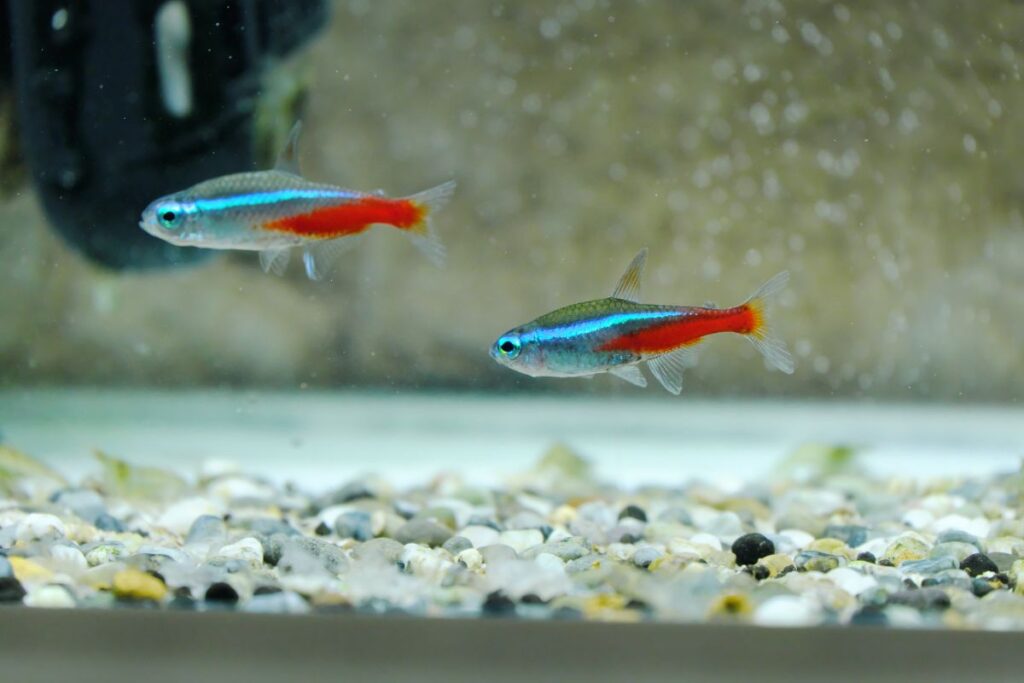
Table of Contents
Species Summary
Neon tetras are a popular freshwater fish species among aquarium enthusiasts. They are known for their vibrant colors and peaceful temperament.
In this section, we will discuss the origin, appearance, lifespan, size, growth rate, behavior, and temperament of neon tetras.
Origin
Neon tetras are native to the blackwater and clearwater streams of South America, specifically in the Amazon basin.
They were first discovered in 1934 by a French explorer named Auguste Rabaut. Since then, they have become a popular species in the aquarium trade.
Appearance
Neon tetras are small fish, typically measuring around 1.5 inches in length. They have a bright blue stripe that runs horizontally along their body, with a red stripe underneath.
Their fins are transparent, with a hint of blue and red. When kept in a well-maintained aquarium, their colors can be even more vibrant.
Lifespan
On average, neon tetras can live for up to 5 years. However, with proper care and a healthy environment, they can live up to 10 years or more.
Size
As mentioned earlier, neon tetras are small fish, typically measuring around 1.5 inches in length. Due to their small size, they are often kept in groups of 6 or more in aquariums.
Growth rate
Neon tetras have a relatively slow growth rate, reaching their full size of 1.5 inches in about 6-8 months. However, their vibrant colors become more prominent as they mature.
Behavior & Temperament
Neon tetras are peaceful and social fish, making them a great addition to community aquariums. They are active swimmers and enjoy having plenty of space to explore.
It’s important to note that they are sensitive to water conditions, so it’s crucial to maintain a clean and stable environment for them to thrive in.
Personally, I have found neon tetras to be a joy to watch in my own aquarium. Their vibrant colors and peaceful demeanor make them a great addition to any community tank.
However, it’s important to remember that they require proper care and attention to ensure they live a healthy and happy life.
Setting Up Your Aquarium
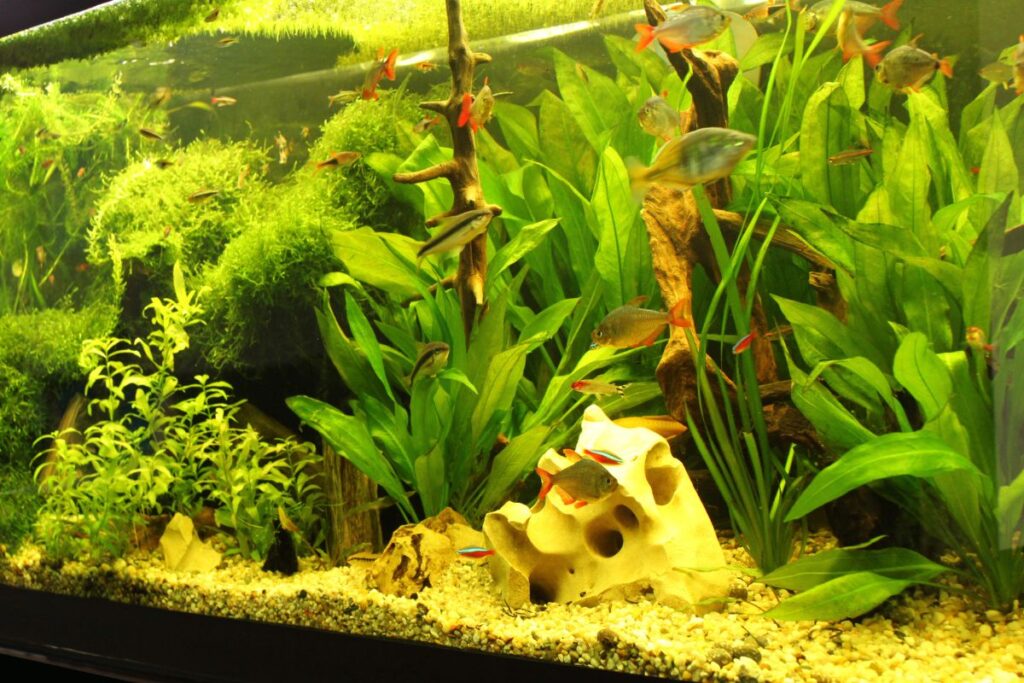
When it comes to setting up an aquarium for neon tetras, there are a few key factors to consider. Here are some tips to help you get started:
Aquarium Size
The size of your aquarium will depend on how many neon tetras you plan to keep. As a general rule of thumb, you should have at least 1 gallon of water per inch of fish.
For a small school of neon tetras, a 10-gallon aquarium should suffice. However, if you plan to keep a larger group of fish, you may need a larger aquarium.
Lighting
Neon tetras do not require intense lighting, but they do need a consistent light cycle. A basic aquarium light will suffice, and you should aim for 8-12 hours of light per day.
Filtration System
A good filtration system is essential for maintaining a healthy aquarium.
Look for a filter that is appropriate for the size of your aquarium and can handle the bioload of your fish. A hang-on-back filter or canister filter are both good options.
Aeration
Aeration helps to oxygenate the water in your aquarium, which is important for the health of your fish. You can use an air stone or a sponge filter to provide aeration.
Heater
Neon tetras are tropical fish and require a consistent water temperature of around 76-80°F.
A heater will help to maintain this temperature, and you should aim for a wattage that is appropriate for the size of your aquarium.
Aquarium Decor
Neon tetras prefer a heavily planted aquarium with plenty of hiding places. You can use live or artificial plants, as well as rocks, driftwood, and other decorations to create a natural-looking environment.
Substrate
A substrate is the material that lines the bottom of your aquarium. Neon tetras prefer a fine-grained substrate that is gentle on their delicate fins.
Sand or gravel are both good options. In my experience, setting up an aquarium for neon tetras can be a fun and rewarding experience.
I remember spending hours carefully arranging plants and decorations in my first neon tetra tank, and it was well worth the effort. By following these tips, you can create a healthy and beautiful home for your fish.
Water Quality
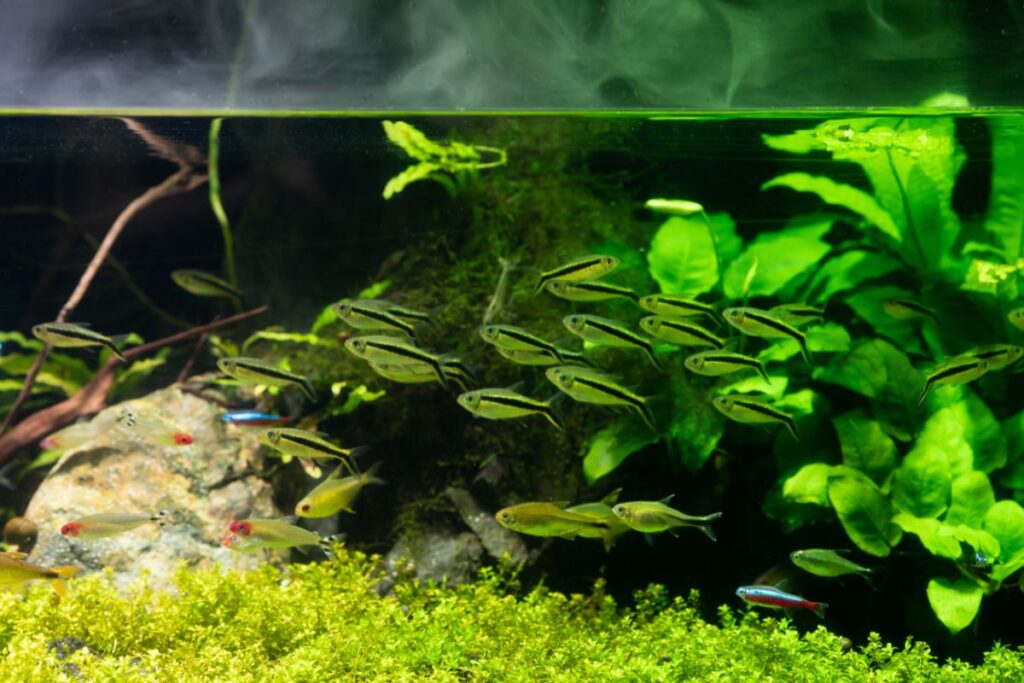
As a neon tetra owner, it is important to maintain proper water quality to ensure the health and happiness of your fish.
Water quality can be affected by a variety of factors, including temperature, pH, and hardness. In this section, we will discuss each of these factors in detail.
Water Temperature
Neon tetras are native to warm, tropical waters, so it is important to maintain a consistent water temperature in your aquarium.
I personally keep my neon tetras at a temperature of 78°F, which seems to be the sweet spot for them. However, they can tolerate temperatures ranging from 72°F to 82°F.
Water pH
Neon tetras prefer slightly acidic water with a pH between 6.0 and 7.0. It is important to monitor the pH of your aquarium regularly, as fluctuations can cause stress and illness in your fish.
If you find that the pH of your water is too high or too low, you can adjust it using pH adjusters that are available at your local pet store.
Water Hardness
Water hardness refers to the amount of dissolved minerals in your aquarium water. Neon tetras prefer soft to moderately hard water, with a hardness level between 1 and 8 dGH.
If your water is too hard, you can use a water softener to bring the hardness level down.
Overall, maintaining proper water quality is crucial for the health and well-being of your neon tetras.
By keeping a consistent temperature, monitoring the pH, and adjusting the hardness level, you can create a comfortable and healthy environment for your fish.
How Often Should I Do Water Changes in Neon Tetra Tanks?
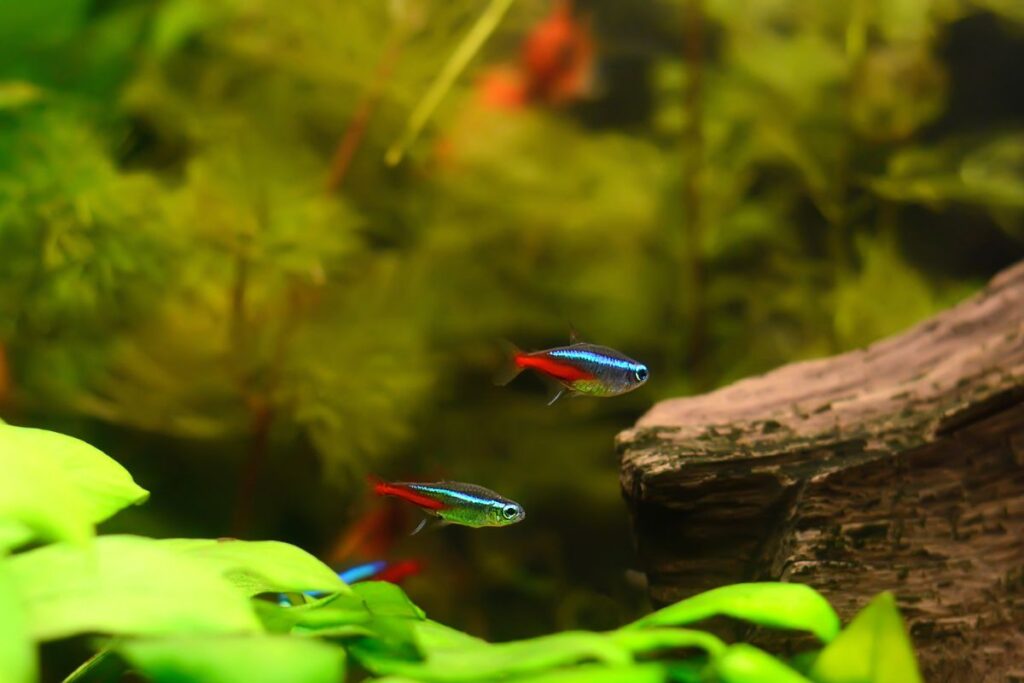
As an aquarium owner, one of the most important things you can do to keep your neon tetras healthy is to maintain clean water. Water changes are an essential part of this process, but how often should you do them?
As a general rule, it’s recommended that you change 10-20% of the water in your neon tetra tank every week. This helps to remove any built-up toxins and waste that can harm your fish.
However, the frequency of water changes can vary depending on a few different factors.
For example, if you have a heavily stocked tank with lots of fish, you may need to do more frequent water changes to keep up with the waste production.
Similarly, if you have a smaller tank, you may need to do more frequent water changes to maintain water quality.
Another factor to consider is the type of filter you have in your tank. If you have a high-quality filter that is properly sized for your tank, you may be able to get away with doing water changes less frequently.
However, if you have a smaller or less efficient filter, you may need to do more frequent water changes to compensate.
Personally, I have found that doing a weekly water change of around 20% works well for my neon tetra tank.
I also like to test my water regularly to make sure that the levels of ammonia, nitrite, and nitrate are within safe ranges. If I notice any spikes in these levels, I will do an additional water change to bring them back down.
In summary, maintaining clean water is crucial for the health of your neon tetras.
While a weekly water change of 10-20% is a good starting point, the frequency of water changes may need to be adjusted based on the size of your tank, the number of fish you have, and the quality of your filter.
Regular water testing can also help you determine when additional water changes are necessary.
Neon Tetra Tank Mates
When it comes to selecting tank mates for your neon tetras, it’s important to consider their peaceful nature and small size. Here are a few compatible species:
- Otocinclus Catfish: These small catfish are peaceful and can help keep your tank clean by eating algae.
- Cherry Shrimp: These colorful shrimp are small and peaceful, making them great tank mates for neon tetras.
- Corydoras Catfish: These catfish are also peaceful and come in a variety of colors and patterns.
- Ember Tetras: These small, colorful fish are similar in size and temperament to neon tetras, making them great companions.
It’s important to avoid aggressive or larger fish that may harm or intimidate your neon tetras. Avoid species such as cichlids, bettas, and larger tetra species.
Personally, I’ve had success keeping neon tetras with cherry shrimp and otocinclus catfish in my own aquarium.
It’s always a joy to watch these peaceful species interact and thrive together in a well-maintained tank.
How Many Neon Tetras Should be Kept Together?

When it comes to neon tetras, it is important to keep them in groups. These fish are social creatures and thrive in a community setting. But how many should you keep together?
As a general rule, it is recommended to keep at least six neon tetras together. This allows them to establish a hierarchy and reduces stress levels.
However, you can keep up to 10-12 neon tetras in a single tank, as long as the tank is large enough to accommodate them.
When choosing the number of neon tetras to keep together, it is important to consider the size of your tank.
Neon tetras are small fish, but they still need plenty of swimming space. A good rule of thumb is to provide at least 1 gallon of water per neon tetra.
It is also important to note that neon tetras are not aggressive fish. They are peaceful and do well with other non-aggressive species.
However, it is best to avoid keeping them with larger, more aggressive fish that may view them as prey.
Personally, I have a 20-gallon tank with 10 neon tetras, and they seem to be thriving.
They are constantly swimming around and interacting with each other, and their vibrant colors add a beautiful touch to my aquarium.
I highly recommend keeping neon tetras in a group, as it not only benefits their physical health but also their mental well-being.
Neon Tetra Diet
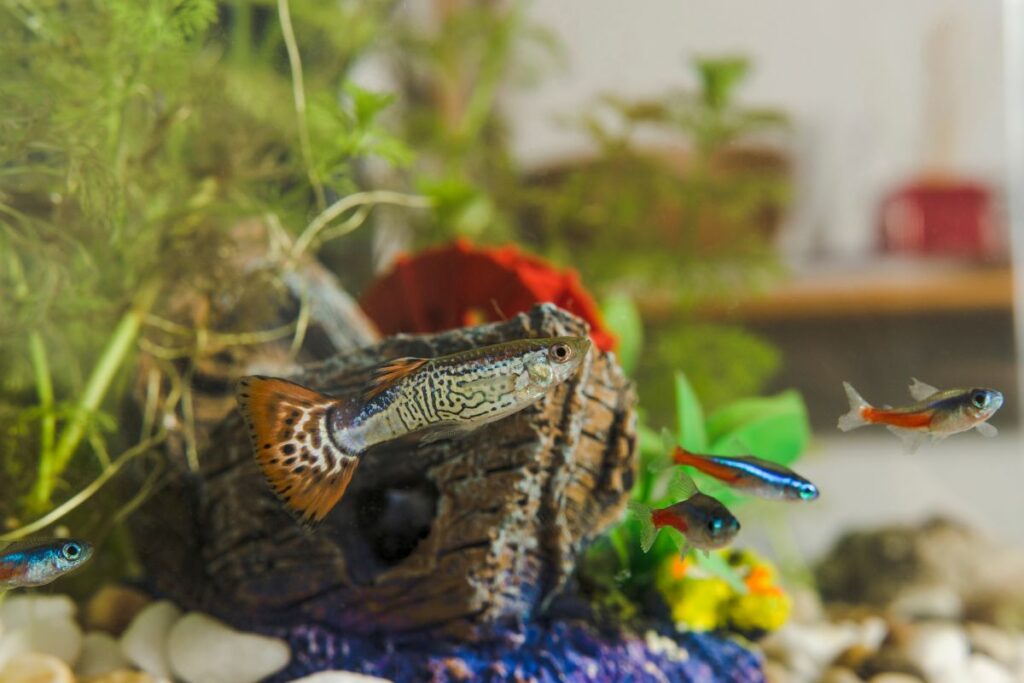
Feeding your neon tetras a balanced diet is essential for their health and longevity. In this section, we’ll cover the types of food that are best for neon tetras and the recommended feeding schedule.
Types of Food
Neon tetras are omnivores, meaning they eat both plant and animal matter. A varied diet is important to provide them with the necessary nutrients. Here are some types of food that are suitable for neon tetras:
- Flake food: This is a staple food for neon tetras and should make up the majority of their diet. Look for high-quality flake food that contains a variety of ingredients, including spirulina and other plant matter.
- Frozen or live food: Neon tetras enjoy eating brine shrimp, bloodworms, and other small aquatic invertebrates. These can be offered as a supplement to their flake food diet.
- Veggie matter: Neon tetras also benefit from eating vegetable matter, such as blanched spinach, zucchini, or peas. These can be given as a treat once or twice a week.
Feeding Schedule
It’s important to feed your neon tetras small meals several times a day rather than one large meal. This will help prevent overfeeding and keep their digestive system healthy. Here’s a recommended feeding schedule:
| Time of Day | Food |
|---|---|
| Morning | A small pinch of flake food |
| Afternoon | A few brine shrimp or bloodworms |
| Evening | Another small pinch of flake food |
Remember to only feed your neon tetras what they can consume in a few minutes. Overfeeding can lead to health problems and poor water quality in your aquarium.
Personally, I have found that my neon tetras love eating live brine shrimp. Whenever I offer it to them, they become very active and excited.
However, I make sure to only give it to them as a treat once or twice a week, as it can be expensive and time-consuming to maintain a constant supply of live food.
Neon Tetra Health
As a pet owner, it’s important to ensure your neon tetras are healthy and happy. Here are some tips on how to maintain their health.
Common Diseases
Neon tetras are relatively hardy fish, but they can still fall victim to a few common diseases.
One of the most common is Neon Tetra Disease, which can be identified by a loss of color and appetite, as well as a curved spine.
Another common disease is Velvet, which is caused by a parasite and can be identified by a gold or rust-colored dust on the fish’s skin.
Signs of Illness
It’s important to keep an eye out for signs of illness in your neon tetras. Some common signs include loss of appetite, lethargy, and swimming upside down or sideways.
If you notice any of these signs, it’s important to take action as soon as possible to prevent the illness from spreading to other fish in the tank.
Treatment Options
If you suspect your neon tetras are sick, there are a few treatment options available. For Neon Tetra Disease, it’s important to isolate the infected fish and treat them with antibiotics.
For Velvet, you can use medication specifically designed to treat parasites. It’s also important to maintain good water quality and keep the tank clean to prevent the spread of disease.
Personally, I once had a neon tetra that developed fin rot. I noticed that its fins were frayed and it was swimming awkwardly. After doing some research, I discovered that fin rot is often caused by poor water quality. I immediately did a water change and added some aquarium salt to the tank. Within a few days, my neon tetra was swimming normally again and its fins had started to heal.
Signs of Healthy Neon Tetras
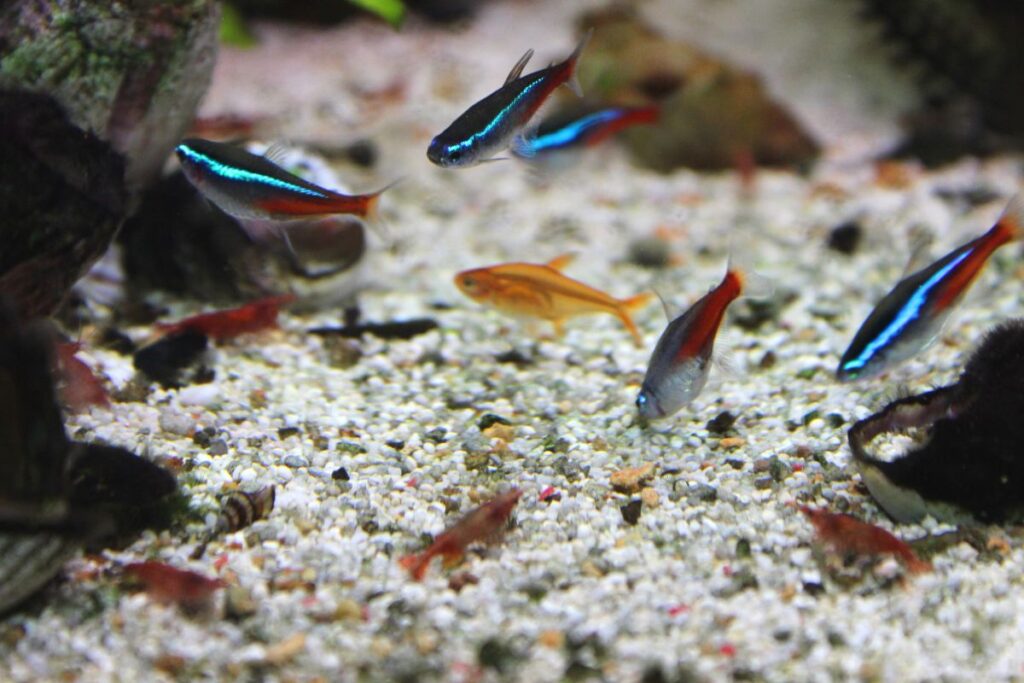
Neon tetras are a popular choice for aquarium enthusiasts, but keeping them healthy requires proper care and attention. Here are some signs to look out for to ensure your neon tetras are healthy:
- Bright Colors: Healthy neon tetras have bright, vibrant colors. Look for a deep blue stripe on their body and a bright red stripe underneath it.
- Active Swimming: Neon tetras are active swimmers, and healthy ones will dart around the tank with ease. If your tetras are sluggish or lethargic, it may be a sign of illness.
- Clear Eyes: A healthy neon tetra will have clear, bright eyes. If their eyes appear cloudy or sunken, it could be a sign of disease.
It’s important to monitor your neon tetras regularly to ensure they remain healthy. If you notice any changes in their behavior or appearance, take action immediately to prevent further illness or disease.
Personally, I have found that feeding my neon tetras a varied diet of high-quality flakes and frozen foods has helped keep them healthy and active.
I also make sure to perform regular water changes and maintain proper water parameters to create a clean and healthy environment for them to thrive in.
Signs of Sick Neon Tetras
Neon tetras are beautiful and vibrant fish that can add color and life to any aquarium. However, like any living creature, they are susceptible to illness. Here are some signs to look out for if you suspect your neon tetras are sick:
- Loss of appetite: If your neon tetras are not eating, it could be a sign that they are sick. Check the water parameters and make sure they are within the acceptable range.
- Clamped fins: If your neon tetras’ fins are clamped close to their body, it could be a sign of stress or illness.
- Gasping at the surface: If your neon tetras are gasping for air at the surface of the water, it could be a sign of poor water quality or a lack of oxygen in the tank.
- Erratic swimming: If your neon tetras are swimming erratically or struggling to swim, it could be a sign of a swim bladder issue or another health problem.
It’s important to monitor your neon tetras closely and take action if you notice any of these signs. The sooner you address the issue, the better chance your fish have of recovering.
Personally, I once had a neon tetra that was showing signs of clamped fins and loss of appetite. I immediately tested the water parameters and found that the pH was too low.
I adjusted the pH and added some aquarium salt, and within a few days, my neon tetra was back to its happy, healthy self.
Breeding Neon Tetras
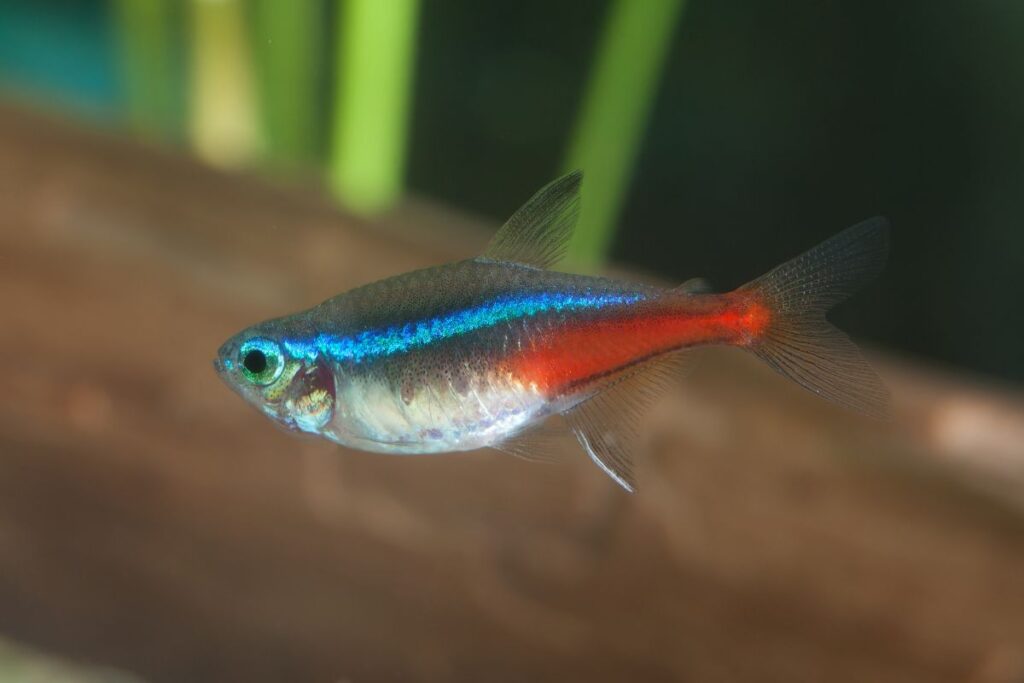
Breeding neon tetras is an exciting and rewarding experience for any fish enthusiast. Here are the steps you need to follow to successfully breed neon tetras.
Breeding Setup
To breed neon tetras, you will need a separate breeding tank. The tank should be at least 10 gallons and should be equipped with a sponge filter.
You will also need a heater to keep the water temperature between 75-80°F. Place some live plants in the tank, like java moss, to provide hiding places for the fry.
Breeding Process
To start the breeding process, you will need a male and female neon tetra. You can tell the difference between the two by looking at their bellies.
The female’s belly will be rounder and larger than the male’s. Once you have a male and female, condition them with a high-protein diet for a week.
After that, place them in the breeding tank and wait for them to spawn. The female will lay her eggs on the plants, and the male will fertilize them.
After spawning, remove the adult tetras from the breeding tank to prevent them from eating the eggs. The eggs will hatch in 24-36 hours, and the fry will start swimming after another 3-4 days.
Caring for Fry
Once the fry start swimming, you will need to feed them small amounts of infusoria or liquid fry food several times a day.
As they grow, you can start feeding them baby brine shrimp or crushed flakes. It’s important to keep the water in the breeding tank clean and well-oxygenated.
Perform daily water changes of 10-20% to keep the water quality high. I remember the first time I successfully bred neon tetras.
It was such an amazing feeling to see the tiny fry swimming around in the tank. Breeding neon tetras requires patience and dedication, but the end result is definitely worth it.
Recommended Products:
- Tetra Whisper EX Silent Multi-Stage Power Filter – This filter is appropriate for a 10-gallon aquarium and can handle the bioload of neon tetras. It is also silent, making it a great choice for those who want a quiet aquarium.
- Hygger Aquarium Air Stone Kit – This kit includes an air stone and a pump, which can provide aeration to your aquarium. It is a great way to oxygenate the water and keep your fish healthy.
- Aqueon Pro Adjustable Heater – This heater is appropriate for a 10-gallon aquarium and can help to maintain a consistent water temperature for your neon tetras. It is also adjustable, so you can set the temperature to your desired level.
- Flourite Black Sand – This substrate is fine-grained and gentle on the delicate fins of neon tetras. It is also rich in nutrients, which can help to promote plant growth in your aquarium.
- NICREW ClassicLED Aquarium Light – This light is basic but can provide the consistent light cycle that neon tetras need. It is also energy-efficient, making it a great choice for those who want to save on their electricity bill.
- Seachem Prime – This water conditioner can help to detoxify ammonia, nitrite, and nitrate, making it safe for your neon tetras. It can also help to promote a healthy slime coat and reduce stress in your fish.
- API Freshwater Master Test Kit – This test kit can help you monitor the levels of ammonia, nitrite, nitrate, pH, and hardness in your aquarium water. It is important to test your water regularly to ensure that it is within safe ranges for your neon tetras.
- Penn Plax Aquarium Decoration – This aquarium decoration is made of non-toxic resin and can provide a natural-looking environment for your neon tetras. It is also easy to clean and can be used with both live and artificial plants.
Conclusion
Neon tetras are a beautiful and delicate species that require proper care to thrive. As I have learned through my own experience caring for these fish, maintaining a healthy environment is crucial for their well-being.
By following the tips outlined in this article, you can ensure that your neon tetras remain healthy and happy. Regular water changes, a balanced diet, and a suitable habitat are all essential components of neon tetra care.
Remember to always monitor your fish for any signs of illness or distress, and take action promptly if necessary. With proper care, your neon tetras can live for several years and bring joy and beauty to your aquarium.
Finally, I would like to stress the importance of patience when caring for neon tetras. It can take time to establish a healthy environment, and it may require some trial and error to find the right balance of food, water parameters, and tank mates.
But with dedication and persistence, you can create a thriving ecosystem for your neon tetras to flourish in.
FAQs
As a neon tetra owner, you may have some questions about how to best care for your fish. Here are a few commonly asked questions:
Q: How often should I feed my neon tetras?
A: Neon tetras should be fed small amounts of food 2-3 times a day. Overfeeding can cause health problems, so be sure to only give them what they can eat in a few minutes.
Q: How often should I clean my neon tetra tank?
A: It’s important to do partial water changes every week to keep the tank clean and healthy for your fish. Use a siphon to remove waste from the bottom of the tank and replace the water with fresh, dechlorinated water.
Q: Can neon tetras live with other fish?
A: Yes, neon tetras are social fish and can live with other peaceful species. However, be sure to research the compatibility of any new fish before adding them to the tank.
Q: Why are my neon tetras losing their color?
A: Stress, illness, and poor water quality can cause neon tetras to lose their vibrant color. Make sure the water is clean and properly balanced, and ensure the tank is not overcrowded. Adding plants and hiding places can also help reduce stress.
Personal Anecdote: When I first got my neon tetras, I was worried about overfeeding them. I started by giving them just a small amount of food once a day, but soon noticed that they were not as active and vibrant as they should be. After doing some research, I learned that neon tetras need to be fed multiple times a day, but in small amounts. Once I started feeding them more frequently, I noticed a big improvement in their health and behavior.
Reference: Wikipedia.
